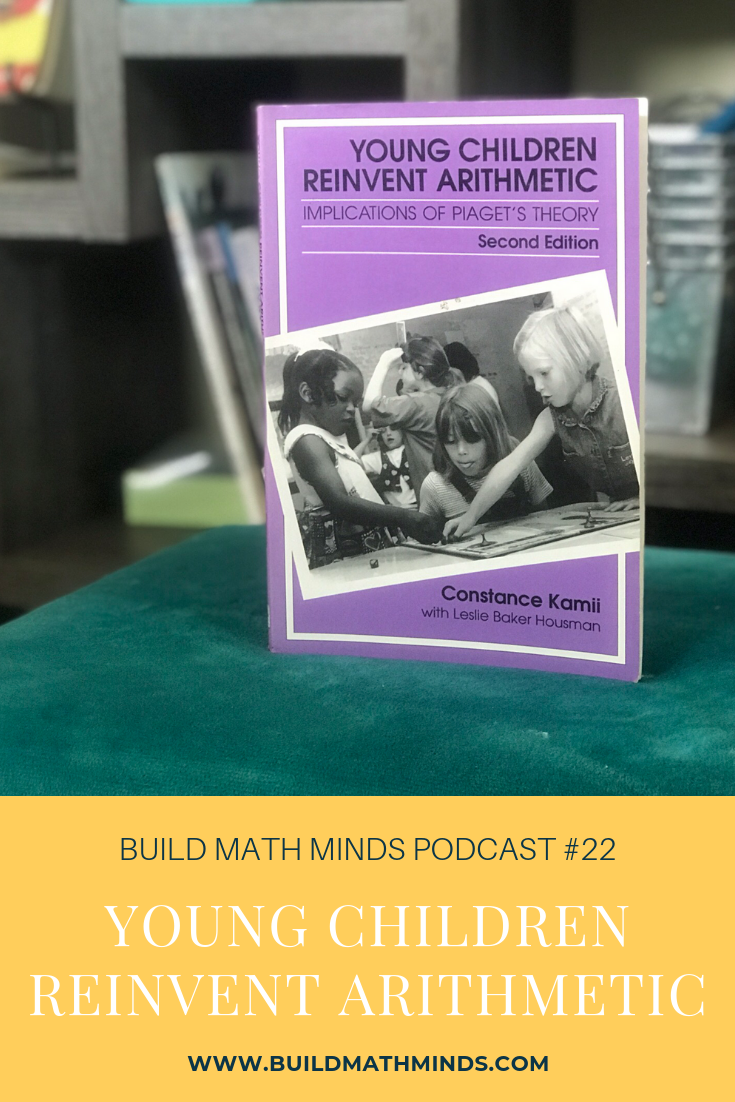Resources mentioned in this episode:
Young Children Reinvent Arithmetic series by Constance Kamii
Welcome fellow Recovering Traditionalists to Episode 22. Today we get insight into how Young Children Reinvent Arithmetic.
Today’s insight comes from the book Young Children Reinvent Arithmetic: Implications of Piaget’s Theory (second edition) by Constance Kamii.
On page 95 she writes:
“We conclude that when addition has become very easy and ‘second nature’ to children, the corresponding subtraction becomes very easy. The way to ‘teach’ subtraction is therefore to strengthen children’s knowledge of sums.
The only way children can get a sum they do not know on their own is by counting. Counting is therefore necessary for children to learn sums. However, subtraction can be derived from sums, and counting is therefore not necessary to learn subtraction. Counting should be avoided in favor of thinking, and this is why we give many addition games and few subtraction games.”
Now even though she says “the only way” to get a sum they don’t know is to count there are other ways, but counting is the way they start. And yes we do tend to have students start subtraction by counting, but in the book she makes the point that if we spend more time helping kids become fluent with addition we don’t need to spend time teaching kids to count to subtract. They can use their knowledge of addition to solve subtraction.
I get asked a lot how to help kids with subtraction and my answer is consistently, work more on addition. This may seem harsh that I don’t think we should be teaching kids strategies to solve subtraction, but if they have strategies for addition they will naturally use those when they see subtraction or they will instantly know the answer because they know the addition fact.
Think of 15 – 7. If kids have built strategies for addition they may look at that and say something like “I know 7+7 is 14 so I just need one more and 7+8 would make 15, so it’s 8.” Or they might just look at that and say “8, because I know that 7+8 makes 15.”
The coolest part about this is that we help kids build the relationship between addition and subtraction and they aren’t learning 121 new facts when we move into subtraction. Instead they are using what they already know about addition to help them build a connection to subtraction.
PLUS, it helps reinforce the real definition of subtraction. Subtraction is finding the difference between two numbers or quantities. Often it is thought of as taking away one amount from another amount. That’s typically the way we refer to it in the early grades. That’s why kids are counting so much. They need to count down 7 in order to take 7 away from 15. But as students progress into upper mathematics (especially with negatives) that idea of subtraction starts to be confusing….How do you take away a negative amount??? I could go on about this for a long time but I’ll wrap it up by saying that if you think of subtraction as the difference that lasts them throughout. So when they see 15 – 7, we want them to think “How far is it from the 7 to the 15? What do I need to add to 7 to get 15?” That version of subtraction lasts them a very long time.
And if you help kids get solid with addition and make the connection to subtraction, that will last them throughout as well.
If you want to dig a bit deeper into how children reinvent arithmetic, then I highly encourage you to read the book.
Subscribe and Review in iTunes
Hey, are you subscribed to the Build Math Minds Podcast, yet? If you’re not, make sure to do that today because I don’t want you to miss any episodes! Click here to subscribe to the podcast in iTunes.
While you’re there, don’t forget to leave a review on iTunes too. I would love to know your thoughts and how we can make sure that we give you content that you will really enjoy.
To leave a review, head over to iTunes and click on “Ratings and Reviews” and “Write a Review.” I can’t wait to hear your thoughts about the podcast.





Christina, this is completely consistent with the abstract concepts of inverse operations. With this in mind, isn’t the corollary principle also true, that the best way to teach division (facts) is to concentrate on strategies for multiplication? The best way to ‘teach’ division is therefore to strengthen children’s knowledge of products. And the best way to teach square roots is to strengthen children’s knowledge of squares? Oh, this can be extended in so many ways, don’t you think? It’s really quite basic and simple but very practical and exciting!
I really enjoy your work, Christina! I’ve been following you for a while on YT and will definitely listen to you here as well.
Hi Christina!
I loved podcast episode 22! My kindergarteners started making the connection of addition to subtraction on their own! Like you said, addition builds the foundation to subtraction. We had the problem 8-3=5. I asked the children if they noticed or saw anything. . .they gave 3+5=8 and 5+3=8. Soon they will also see that last fact to complete the fact family. We use Eureka Math which is worksheet heavy but I choose to do hands on activities more instead of a lot of those worksheets. These hands on activities help my kinders see hos the numbers work!
Thank you for your Facebook groups, math workshops, and podcasts! I love them all!
Well thought out as usual.
Thank you Christina! Podcast #22 will help me build the math mindset for my struggling 4th graders. I really appreciate your expertise.